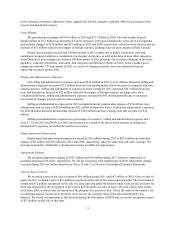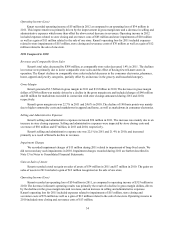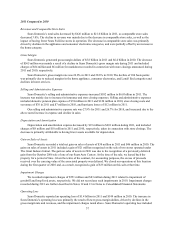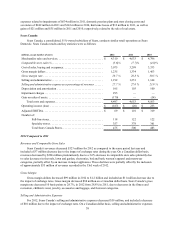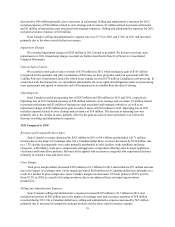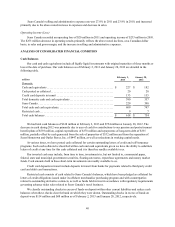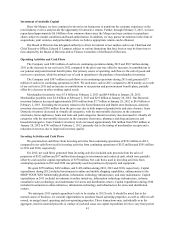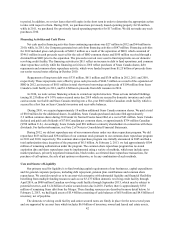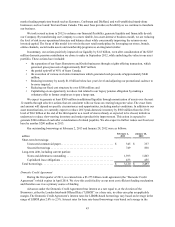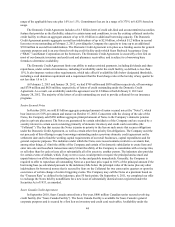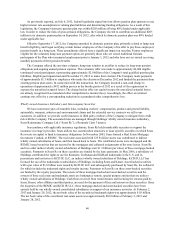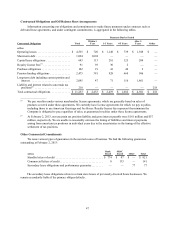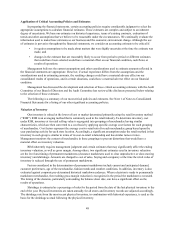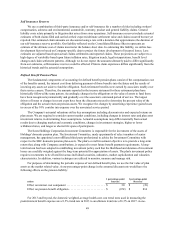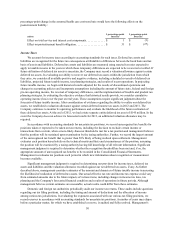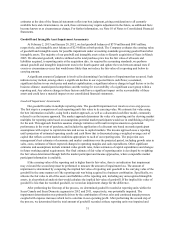Sears 2012 Annual Report Download - page 41
Download and view the complete annual report
Please find page 41 of the 2012 Sears annual report below. You can navigate through the pages in the report by either clicking on the pages listed below, or by using the keyword search tool below to find specific information within the annual report.41
Investment of Available Capital
Since the Merger, we have continued to invest in our businesses to transform the customer experience as the
retail industry evolves and provide the opportunity for attractive returns. Further, through February 2, 2013, we have
repurchased approximately $6.0 billion of our common shares since the Merger and may continue to repurchase
shares subject to market conditions and board authorization. In addition, we may pursue investments in the form of
acquisitions, joint ventures, and partnerships where we believe appropriate returns can be obtained.
Our Board of Directors has delegated authority to direct investment of our surplus cash to our Chairman and
Chief Executive Officer, Edward S. Lampert, subject to various limitations that have been or may be from time to
time adopted by the Board of Directors and/or Finance Committee of the Board of Directors.
Operating Activities and Cash Flows
The Company used $303 million of cash in its continuing operations during 2012 and $307 million during
2011 as the decrease in our net loss in 2012 compared to the prior year was offset by increases in contributions to
our pension and postretirement benefit plans. Our primary source of operating cash flows is the sale of goods and
services to customers, while the primary use of cash in operations is the purchase of merchandise inventories.
The Company used $307 million in cash flows in its continuing operations during 2011 and generated $77
million of cash in its continuing operations in 2010. We used more cash in 2011 compared to 2010 mainly as a result
of our net loss in 2011 and an increase in contributions to our pension and postretirement benefit plans, partially
offset by a decrease in other working capital needs.
Merchandise inventories were $7.6 billion at February 2, 2013 and $8.4 billion at January 28, 2012.
Merchandise payables were $2.8 billion at February 2, 2013 and $2.9 billion at January 28, 2012. Our Domestic
inventory balances decreased approximately $895 million from $7.7 billion at January 28, 2012 to $6.8 billion at
February 2, 2013. Excluding the inventory related to the Sears Hometown and Outlet store businesses, domestic
inventory decreased $501 million from the prior year due to both improved productivity and store closures. Sears
Domestic inventory decreased in virtually all categories, with the most notable decreases in the consumer
electronics, home appliances, home and tools and paint categories. Kmart inventory also decreased in virtually all
categories with the most notable decreases in the consumer electronics, pharmacy and drug and grocery and
household categories. Sears Canada’s inventory levels increased approximately $46 million from $745 million at
January 28, 2012 to $791 million at February 2, 2013, primarily due to the timing of merchandise receipts and a
reduction in reserves due to improved inventory quality.
Investing Activities and Cash Flows
We generated net cash flows from investing activities from continuing operations of $191 million in 2012,
compared to net cash flows used in investing activities from continuing operations of $352 million and $391 million
in 2011 and 2010, respectively.
For 2012, net cash flows generated from investing activities included cash proceeds from the sales of
properties of $532 million and $37 million from changes in investments and restricted cash, which were partially
offset by cash used for capital expenditures of $378 million. Net cash flows used in investing activities from
continuing operations in 2011and 2010 was primarily used for purchases of property and equipment.
We spent $378 million, $432 million, and $ 426 million during 2012, 2011 and 2010, respectively. Capital
expenditures during 2012 included investments in online and mobile shopping capabilities, enhancements to the
SHOP YOUR WAY Membership platform, information technology infrastructure, and store maintenance. Capital
expenditures in 2011 included investments in online initiatives, information technology infrastructure, in-home
consultative sales technology, and maintenance for stores and distribution centers. Capital expenditures during 2010
included investments in online initiatives, information technology and infrastructure for stores and distribution
centers.
We anticipate 2013 capital expenditure levels to be similar to 2012 levels. It should be noted that in the
normal course of business, we consider opportunities to purchase leased operating properties, as well as offers to sell
owned, or assign leased, operating and non-operating properties. These transactions may, individually or in the
aggregate, result in material proceeds or outlays of cash and cause our capital expenditure levels to vary from period


